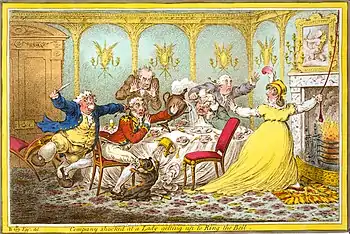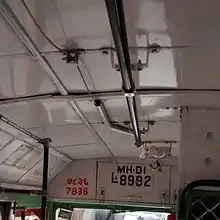Bell pull
A bell pull is a woven textile, pull cord, handle, knob, or other object that connects with a bell or bell wire, and which rings a service bell when pulled. Bell pulls may be used to summon workers in homes of people who employ butlers, housemaids, nannies or other domestic workers,[1][2] and often have a tassel at the bottom.[3] The bell pull is one element of a complex interior mechanical network which, in Victorian times, typically involved a range of bell pulls in different rooms, connected to a central bank of labelled bells in a room where servants would wait to be summoned.[2]

Central bell panel
In the 19th century, some hotels also had a panel with a bell for each room, as part of a centralized bell system.[2]
Transport
A bell pull is used in some forms of public transport, mostly buses, for passengers to signal to a driver to halt at a particular bus stop.[4]
Coffee Shops
A bell pull was widely used in market streets of old towns in Anatolia to notify coffe shop attendant. Upon ringing the bell, atendant goes out from the shop briefly and notices the store owner ordering coffee or tea. They negotiate using hand signs briefly and its all set. Tea comes to store. Each bell line was pulled by small drops tied to main line and could serve around 10-15 customer shops. Different directions and corners had different ropes going out and different tone bells were attached. It later evolved to common line multi-drop electronic diaphone, then today evolved to walkie talkies handed by coffe shop owner to stores in specific frequency.
See also
References
- "Englishmen's Dining Rooms" (PDF). New York Times. 2 September 1894. Retrieved 28 October 2010.
- Larry Nash White; Emily Blankenship White (February 2004). Marietta. Arcadia Publishing. pp. 34–. ISBN 978-0-7385-3231-8. Retrieved 15 November 2011.
- "New London Millinery". Poverty Bay Herald. 18 November 1911. Retrieved 28 October 2010.
- SULZBERGER, A.G (12 May 2009). "Is This Your Stop? Pull the Cord, Like Old Times". The New York Times. New York. Retrieved 9 May 2015.
